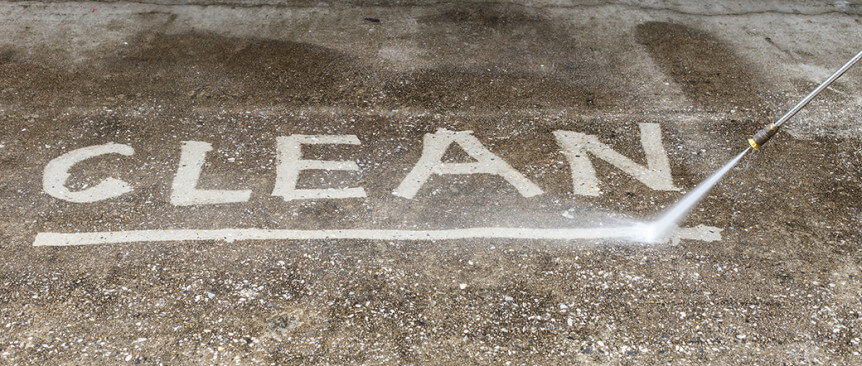
Concrete looks tough—and it is—but that doesn’t mean it’s indestructible. Many homeowners fire up their pressure washers thinking concrete can handle anything, only to end up with etching, pitting, cracks, or streak marks they can’t undo. 😬
So, can pressure washing damage concrete? Absolutely—if you don’t use the right techniques. In this article, we’ll explain how damage happens, what causes it, and how to avoid turning your driveway or patio into a patchy mess.
🛠️ How Pressure Washing Can Damage Concrete
Pressure washers blast water at 1,500 to 4,000 PSI or more. That kind of force is great for removing grime, but when misused, it can:
- Etch the surface: This means creating permanent streaks or lines in the concrete
- Erode the top layer (cream layer): This weakens the surface and makes it more porous
- Chip corners and edges: Especially on steps or decorative features
- Cause cracking: If the water gets deep into small cracks and expands (especially in cold temps)
- Blast out expansion joints or mortar in stamped or segmented areas
Concrete is strong, but it’s also porous and can be worn down over time. It’s like scrubbing your skin with sandpaper—there’s a right way and a wrong way. 🧼🧱
🔎 Signs You’ve Damaged Your Concrete
Not sure if you’ve gone too far? Look out for:
- Visible swirl or fan marks from nozzle spray
- Pitted or gritty texture where it used to be smooth
- Uneven coloration from etching
- Chipped edges around expansion joints
- Water sitting in new dips or divots that weren’t there before
Some of these issues may not be noticeable until the surface dries completely—and by then, it’s often too late. 😟
✅ How to Pressure Wash Concrete the Safe Way
1. Use the Right PSI
- Residential concrete (driveways, sidewalks): 2,000–3,000 PSI is plenty
- Decorative or stained concrete: 1,500–2,000 PSI max
- Commercial/industrial concrete: May tolerate higher PSI (up to 4,000), but only with pro-level machines and know-how
💡 More PSI doesn’t mean better cleaning—just more risk of damage.
Browse Amazon Here For Popular Pressure Washers And Accessories
2. Choose the Right Nozzle
- Use a 25° (green) or 40° (white) nozzle for general cleaning
- Avoid 0° red tips unless you’re stripping paint or stuck-on gum—and never on decorative or stamped concrete
🎯 Wide-angle nozzles clean more gently and evenly.
3. Keep the Nozzle Moving
- Never hold the spray in one spot
- Use sweeping motions, overlapping each pass
- Keep the nozzle about 12 inches from the surface
This reduces the risk of etching and gives you a more even clean.
4. Start Low, Test First
Always test a small, inconspicuous area before tackling the whole driveway or patio.
🔍 If you see any lightening, scarring, or roughness forming—dial it down immediately.
5. Use a Surface Cleaner Attachment (Optional but Awesome)
These round, disc-like tools:
- Keep a consistent distance from the surface
- Clean evenly without streaks
- Reduce user fatigue
🌀 They’re great for cleaning large areas of concrete quickly and safely.
🧴 Should You Use Chemicals?
Concrete cleaners and degreasers can:
- Loosen dirt and stains
- Allow you to use lower pressure
- Prevent over-spraying and rework
Just make sure they’re rated for concrete and that you rinse thoroughly afterward. 💧
❌ Common Mistakes to Avoid
- Using a zero-degree nozzle on standard concrete
- Starting with max pressure right away
- Spraying too close to the surface
- Cleaning in cold weather, where water can seep into cracks and freeze
- Not testing first
Even pros can scar concrete if they rush. Take your time—it’s worth it.
🧠 Final Thoughts
Yes, concrete is tough—but pressure washers are tougher if used carelessly. 🚫🧱💦
To clean safely:
- Use appropriate pressure and nozzles
- Keep the spray moving
- Test small areas before going full throttle
- Consider using a surface cleaner or chemical pre-treatment
A well-cleaned concrete surface looks amazing and lasts longer—but only if you treat it with respect. Handle your pressure washer like a precision tool, not a blunt instrument, and your concrete will thank you for years to come. ✅🧼🌟
Browse Amazon Here For Popular Pressure Washers And Accessories






